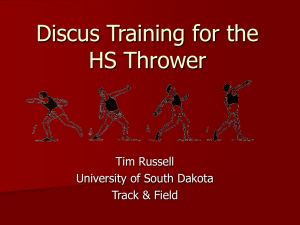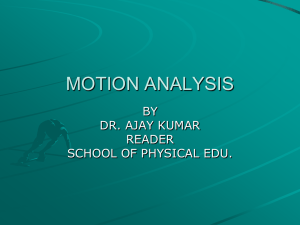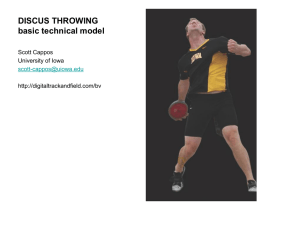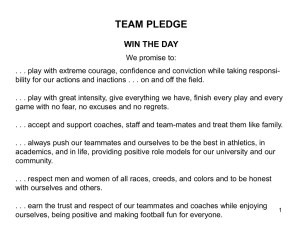NTCA Handbook - Gsparish.org
advertisement
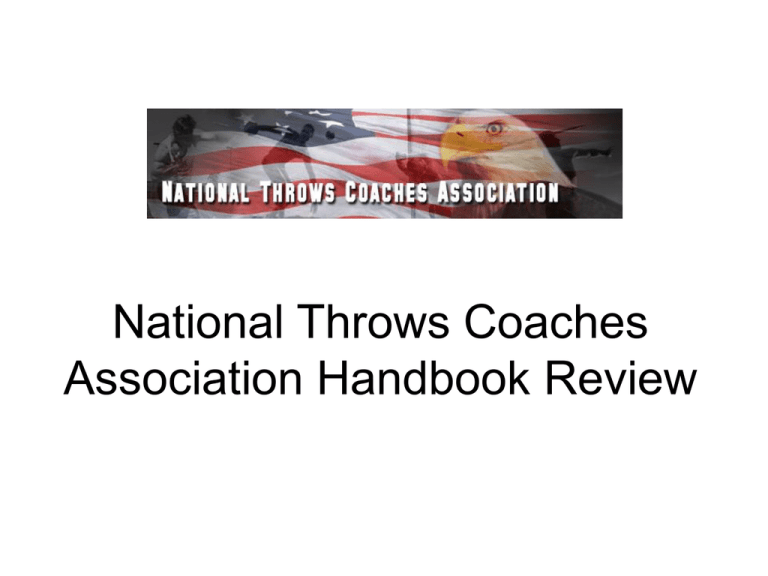
National Throws Coaches Association Handbook Review Warm-up Strategies for Throwers by Glenn Arnold • Prepare physiologically, increase the heart rate which will increase the core body temperature. This will allow for more elasticity of muscle fiber; and psychologically, increase focus. Warm-up Strategies for Throwers by Glenn Arnold • Effective pre-competition time - “throws out of competition don’t count” – Timing • Provide ample time for a full warm-up (stretch, form running, warm-up throws, etc.) • recommendation: start the flight before, 20-30 minutes – Intensity • Don’t will the warm-up • Recommendation: 80-90% effort, execute proper technique, save energy for competition throws, gain a mental edge by knowing that you have not given your all – Volume • This is not the time to work on correcting a technical flaw • Recommendation: athletes should keep their event-specific throws brief, 5-8 throws, standing throws, South African, full throws, etc. Warm-up Strategies for Throwers by Glenn Arnold • Effective pre-competition time - “External imaging is done by the athlete visualizing the skill as an observer” – Focus • Stay on your path • Develop a routine to increase level of comfort and focus • Familiarize yourself with any visual cues that you will use during competition – Visualization • Get an internal and external perspective – mental recaps • Internal – How much knee flexion do I have, where is my center of gravity, when do I aggressively extend my hips? • External – visualize as an observer, What does my movement look like, am I in the correct position, did I get separation between my upper and lower body? – Concluding Remarks • In a sport of inches, EVERYTHING matters Developing Discus Technique by Scott Cappos • The Wind-Up: 12:00 is used as the back of the circle – – – – Overview • Individual – beginners 1-2 winds to establish a rhythm Lower Body • Straddle the centerline in the back of the circle • Them move into a half-squat position, with the feet flat and the weight evenly distributed. • Beginners, both legs should remain flat for stability and balance. • Evenly distribute weight or slightly more on the left side, with little weight transfer from left to right during the wind Upper Body • Lean forward slightly, chest over the knees • Right arm at the side, begin the wind – the right arm moves toward the left side, between the hip and the shoulder. The disc is brought back to the right side and is locked out behind the hip. • The left arm aids in the wind by catching the discus as it moves to the left side • The left arm should be long and straight at shoulder height over the left knee as the athlete begins to start the turn. The left arm remains at shoulder lever and work with the left knee as a unit during the wind-up and set-up Drills • Repeat Wind-ups: The thrower practices the winding motion , resets, and repeats the motion. Learn how to set –up the start of the throw Developing Discus Technique by Scott Cappos • The Set-up – – – – Overview • The right foot sweeps past the left side of the body and leads the throw. The left side will remain as one unit and keep the body on balance. • Hold the 9:00 position until the body is ready to SPRINT to the middle. Lower Body • After the wind-up, the throw is initiated with a shift in the weight to the left side and the right foot pushing off and leading the throw, at the 9:00 position, the right foot will lead the throw, followed by the knee, then the hip. • The right toe should clear past the left foot before the athletes starts the sprint to the middle. • The left leg should stay low and flexed, ready to push off toward the front of the circle. Upper Body • The discus remains behind the hip; the left arm should stay long and remain at shoulder level. Drills • Step-Out: complete a wind and step out with the right leg, tapping it on the ground at the 9:00 position (South African position). The left side should point at 9:00, with the shoulders lever. The left leg will support most of the body weight (90%+) • Turn to the Middle: Execute the first half of the throw, but the left leg remains in the back of the circle. • The shoulders face the center of the sector(6:00), and the right foot lands at 3:00 near the middle of the circle Developing Discus Technique by Scott Cappos • The Sprint – – – Overview • Set-up a good throwing position and increase the speed of the throw. The rhythm of the throw is SLOW to FAST: the tempo of the throw increases at this point Lower Body • The right foot leads the sprint to the middle. The sprint is from the right foot, knee and hip. As the right foot makes contact, it should land just past the centerline and land between 1:00 and 3:00. The left leg is flexed and actively pushing from the back of the circle to set up the power position. An active left leg helps speed up the lower body. If this step is executed properly, there will be a non-support phase, and when the right foot makes contact, the left leg should near 9:00 • Also keeping the left knee close to the right knee as it drives to the front increases the leg speed and created even more torque Upper Body • To create torque, the upper body should stay square to the center of the sector as long as possible to enhance the separation of the upper and the lower body. Developing Discus Technique by Scott Cappos • The Sprint – Drills • Tap and Go: – The thrower performs a step-out, and then works on sprinting from the 9:00 position, landing in the power position. Keep very little weight on the right leg on the step-out • Turn to Power Position: – Page 18 • Tap and Go with Lift: – Page 18 Developing Discus Technique by Scott Cappos • The Throw – – – Overview • The discus thrower feels a long and powerful pull on the discus, as the legs turn and lift during the execution of the throw. • If the athletes throws with a reverse, the right foot should land flat after the throw is completed, with the head/shoulders staying down until balance is gained Lower Body • After the right leg makes contact just past the middle of the circle, it must continue to turn, while the left leg snaps down to the from of the circle • The athlete should keep most of the body weight on the right foot until the release • The left leg remains slightly bent until the athlete is ready to release the implement. • The legs will lock out and drive upward just prior to the release of the discus Upper Body • The shoulders are back and over the right leg as it turns • Since the hips lead the throw, the upper body is waiting to strike • As the legs turn, the left arm opens up and stretches high across the chest • When the thrower is ready to finish, the chest and head drive upward with the legs • The chest is driven up to meet the left arm, which is now pulling in for the block • The right arm extends out and executes the discus throw Developing Discus Technique by Scott Cappos • The Throw – Drills • Standing barbell throw: • Coaching Progression – No reverse throws are used during all phases of training • • • • • No discus Light barbell / cones Light standard discus Standard discus Heavy discus Discus Drills for the Beginners by Scott Cappos • A basic technical model – – – – – – Wind Single-support –left leg No support Single-support – right leg Power position Throw Discus Drills for the Beginners by Scott Cappos • Non Throwing Drills for the Discus – – – – – – 6:00 front Winding 3:00 9:00 • Proper start of the throw: 12:00 back • Emphasis on the whole winding motion, not just winding again and again • Prepares for the next phase Wind and step-out: • The athlete completes a wind and steps out with the right leg, tapping it on the ground at the 3:00 position • The left side should point at 3:00 with the shoulders level • The left leg will support most of the body weight (90%) Wind, step-out, and step to the middle: • Complete the previous drill, then step with the right foot to the middle of the circle. Wind, step-out, step to the middle, and turn to the power position: • Add to the previous drill by turning the right foot in the center of the drill, and then completes the drill by finishing in the power position. Wind, step-out to and turn to the power position • The thrower performs a step out, and then works on sprinting from the 3:00 position, landing in the power position. The drill should simulate the actual body position in the full throw, keeping very little weight on the right let on the step out Turn to the power position • The athlete executes the initial throwing motion, landing in the power position, the emphasis is on balance and landing in a good throwing position, with most of the body weight over the right leg Discus Drills for the Beginners by Scott Cappos • Throwing Drills for the Discus – Bowling: The discus is released with a clockwise rotation off the index finger. The thrower rolls the discus off the hand near the ground and focuses of the clockwise release of the implement – Tosses: release from the side of the body, teach proper release technique and develop confidence that the discus will not fall off the hand if the implement is in motion – Standing throw: power position, feet wider than shoulder with. The discus starts on the left side, and then wind the discus back 270 degrees and turn the right leg into the left side – Half-turn throws: set up in the middle of the circle. The right foot is placed at 9:00 and the upper body is facing the center of the sector. The discus is at the side of the body. The focus of the throw is an active turning of the right foot, as the upper body stays back a long as possible – Multiple half-turn throws: – Slow full throws, NO REVERSE: – Full throws, NO REVERSE: Discus Drills for the Beginners by Scott Cappos • Throwing Drills for the Discus – Multiple half-turn throws: – Slow full throws, NO REVERSE: – Full throws, NO REVERSE: Discus Drills for the Beginners by Scott Cappos • Drills with a throw – The drills provide the coach with the sequential opportunity to evaluate the positioning of the thrower. During each phase of the drill, there is a long pause during which time the coach checks the positioning of the thrower. At the conclusion of the checking, the next phase of the drill/throw is completed • • • • • Wind, step-out, step to the middle, turn to the power position, standing throw Wind, step-out and turn to the power position, standing throw Turn to the power position, standing throw Wind, step-out, step to the middle, half-turn throw Wind and step to the middle, half-turn throw
